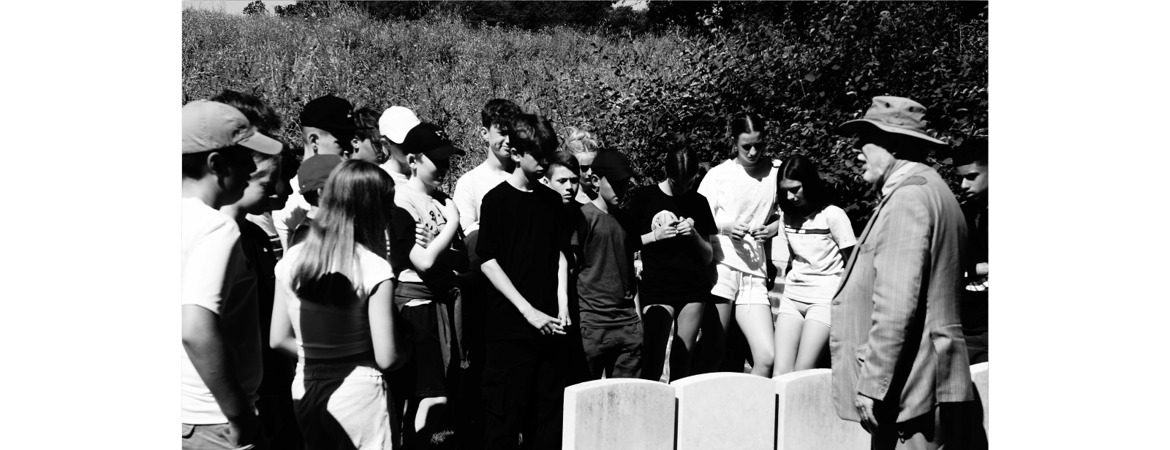- Home
- School Life
- News
- Battlefields Trip
Battlefields Trip

Report by Sophia, 8B
Last Friday and Saturday, some Year 8 students had the opportunity to visit France and Belgium in order to gain information into what life was like during WW1.
Our trip began at 04:00am when we met at school ready to take the ferry over to Calais. On the way, we collected our brilliant tour guide, Allan.
Once we had arrived, we drove to Belgium and our first destination was a WW1 Museum. Here, there were recreated trenches from both the British and Germans allowing us to see that the German ones had better footing and stronger walls. The museum had also recreated a dugout for us to explore!

After this, we visited Tyne Cot (a British cemetery where we placed a wreath of poppies under the Berkshire regiment) and Langemark (a German cemetery) and the difference between the two was shocking. Tyne Cot had white graves for every soldier, flowers decorating the cemetery and room on the graves to see the soldiers’ rank, name, religion, date of death and possibly a chosen message from the family. Being here made me feel so grateful that the war ended so people today aren’t still having to fight but also upset due to the number of deaths and the fact that people were lied to as to what life as a soldier would entail.
Different to Tyne Cot, Langemark was shaded by oak trees, small slabs acted as graves and only certain soldiers got them. Even if they did, due to them being mass graves, the only thing you could fit on the slabs were the names of the soldiers or the number of unknowns who had died. In Langemark, I feel the most moving things were statues of the soldiers and a mass grave which held 25,000 soldiers, two of whom were British.
Following this, we got the opportunity to walk through a trench actually used in WW1! This was super cool, and it was really fun if a little muddy! It was really cool to see where the bullets had pierced the walls and trying to fit under tin ceilings.

We spent the end of day one in Ypres (pronounced Eeps) where we went to a Belgium chocolate factory, which was very exciting! In Ypres we also saw the last post being performed by volunteers from the fire station. Did you know, they have been doing this every night since the end of WW1?! Day one was incredible and after discovering our dorms and spending the night in France, we begun day two!
After a baguette and hot chocolate breakfast, we left our accommodation to go to our first stop of the day, a smaller British cemetery called Mansel Copse. Here, we saw the grave of Noel Hodgson, a poet and lieutenant of WW1, whose final poem predicted his own death. Our tour guide told us Hodgson’s batman was very loyal. Once, he brought Hodgson a bath back from no-man’s land! Did you know, his batman wasn’t Ogden who everyone thought it was but was really a different man called Weston?
After this, we visited the biggest crater from WW1 (Lochnagar Crater) and it is HUGE! It was created by a mine placed by the British but, as it was made from chalk, it was light enough to make the men working on it snow-blind!
Towards the end of the day, we visited two more destinations. One of which was the Thiepval memorial, one of the largest memorials in the world and it had the name of every single British casualty of the Somme on its walls! It was an incredible monument yet shocking to see the vast number of names written up on the walls and graves. I also found it fascinating to see how there were an equal number of French and British graves there.

Our final stop was at Beaumont Hamel Newfoundland cemetery. This was land bought by the women in Newfoundland who’d lost their loved ones during the battle of the Somme and reserved the site so people could see what it was like. It was different to the other cemeteries we’d visited as the lost soldiers were still in the ground beneath our feet - not in graves. This site was incredible as we saw trenches as well as a memorial for the Scotts who fought and helped the victory of the British during the battle. Did you know they were still fighting in their kilts in WW1?
After this, we got back on the ferry and returned home. The trip was incredible with my favourite part being the trenches as well as learning the difference in graves for both sides of the war based on their outcome. Thank you so much to Alan for being a great tour guide and to Mr Espensen, Miss Brown, Mr Metson and Mr Cook for organising and taking us on the trip. We learnt so much and had a fantastic time!
By Sophia
8B

